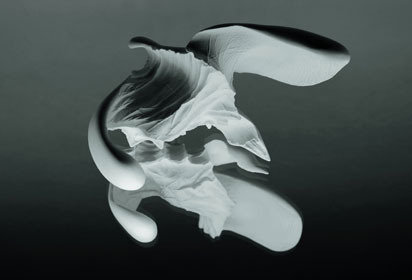Pauline M'barek
dal 4/4/2014 al 9/8/2014
Segnalato da
4/4/2014
Pauline M'barek
KIT - Kunst im Tunnel, Dusseldorf
The Tangible Border. This multi-part installation focuses upon how we experience the world through our body and its senses.

„The world is that which we perceive.“
For the Düsseldorf Quadriennale 2014, Kunst im Tunnel (KIT) will host an exhibition by Pauline M'barek (born 1979). The artist has developed a multi-part installation designed specifically in response to KIT's unique architecture and which sets out to explore boundaries and their points of contact by means of light projections, videos and objects. It focuses upon how we experience the world through our body and its senses. Upon entering the exhibition, we are released from our everyday, automatic patterns of perception and absorbed by a space in which thresholds rather than boundaries await us.
Pauline M'barek has created an atmosphere of mutual attentiveness and explores the moment of contact between the person and the art objects on display. Her starting point is the idea that if we look at an object with the expectation of sensing it, then the sensed phenomenon grasps our own gaze and then our whole body. In other words: what I grasp also grasps me.
In an exhibition of visual art, this 'grasping' process does not ordinarily involve physically touching the works with our hands. In almost every gallery space, we are told: “do not touch”. Instead, visual contact is desired or even demanded; the eye probes the object and registers its nature and its aura. Only through the act of conscious seeing does the exhibited work, which has been made to be seen, actually become visible. Through a hybrid form of touching and seeing, we, the viewers, experience a contact forming between our bodies and the art object.
We experience a proximity at this border that, in our everyday lives, we obtain primarily through our hands, the main mediators between body and matter. With its precision and fine motor skills, the hand is an anatomical marvel, the ultimate tool. The hand allows us to bend, twist and knead material, and to exert enormous force. At the same time, the hand is also the only part of the body that can carry out the finest, most delicate movements. However, it is the sense of sight - associated with what is distant and abstract - that is more important in the gallery space.
“The Tangible Border” explores the dissolution of the boundaries between the senses that cater for close and distant viewing, inviting us to participate in the optical, physical and conceptual inversion of bodies and relationships, literally turning them inside out. To this end, Pauline M'barek has used light and shadow to tilt and fold the space, creating palpable tension by dissolving stable viewpoints.
The exhibition is like a laid-out course, traversed by a white line. Video sequences depicting a vessel being thrown in clay on a pottery wheel, filmed in close-up from different angles, are projected on to the wall. They show how unstable rounded forms are created and undergo various metamorphoses via the rotation of the wheel and skilful manipulation of the borders or edges. We can observe and experience the overall process of form in the making which is itself the result of an interaction between material and moving hands over a certain period of time: a unity of shape, volume and contour. Our gaze is at once both outside and inside this unity; thus we experience the vessel as a body, as a boundary, that simultaneously creates and encircles a void. The idea of the “tangible border” accrues a vivid, practical meaning here.
An illuminated shelf of reflective glass extends through the semi-darkness of the room for several metres.
It holds over a hundred amorphous objects, which, on closer inspection, turn out to be negative imprints of diverse hand movements. The space that had been turned into a vessel by hands during the potting process duly becomes an imprint, an archaeological find, which raises all manner of questions: which moment has been 'frozen' here? Has an invisible shape been ossified here? Are we looking at gestures of touch arranged like an alphabet? Or is it a process?
Our eye encounters a map of lines, surfaces and grooves. These features evoke memories of hands in different positions, working hands, hands clasped in supplication or prayer. The reflective shelf serves as a base, raising the objects to a suitable height for viewing, duly defines the space and its surroundings. It reproduces the hand shapes and creates visual perplexity as they constantly oscillate between the concave and the convex.
In another video, a glove moves as if by magic from the left to the right hand, recalling one of Salvador Dali's last verified quotes: “The universe is an inside-out glove.” In the context of the exhibition, the glove demonstrates the inversion of the relationship between the internal and the external, and defines our position in relation to the images we behold. We draw these images from the outside inwards, where they transform and enhance our inner selves. This makes us, the viewers, part of an experiment: surrounded by Pauline M'barek's installations, we experience an unsettling visual impression; our curiosity leads us to the boundary between light and dark, between seeing and touching. We recognise that the focused, probing gaze is the opposite of the haphazardly roving eye. We touch the border of intangible things with this gaze - a border to which we may have been oblivious and which opens up new perspectives that transcend today and the exhibition, ultimately granting us a more autonomous way of looking at the world.
Gertrud Peters
Image: Pauline M’barek, Artefacts, 2014. Alabastergipsabdruck
Press and PR
Dirk Schewe
Tel.: +49 (0)211 - 8996256
presse@kunst-im-tunnel.de
KIT - Kunst im Tunnel
Mannesmannufer 1b - 40213 Düsseldorf
Tue–Sun: 11am–6pm
Admission: EUR 4
Concessions: EUR 3
Groups visits (from 10 people on): EUR 3
Disabled visitors: free admission
Children and teens aged under 18: free admission



